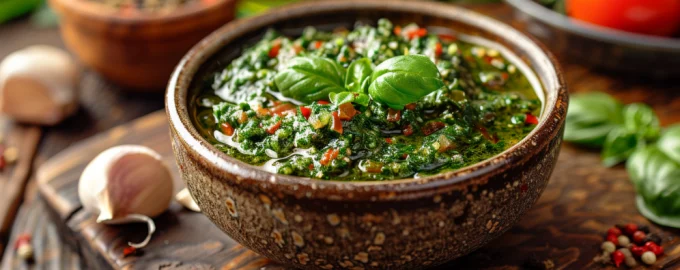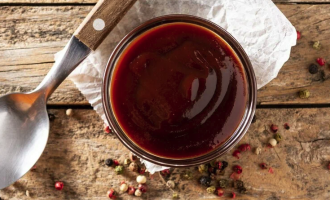Pesto sauce, originating from Genoa in the Liguria region of Italy, is a vibrant and aromatic sauce that has been a staple of Italian cuisine for centuries. The word “pesto” comes from the Italian verb “pestare,” which means to pound or crush, referring to the traditional method of preparing the sauce using a mortar and pestle. This method releases the full flavor of the ingredients, creating a rich and complex sauce. Classic pesto, or pesto alla genovese, is made with fresh basil, garlic, pine nuts, Parmesan cheese, olive oil, and a touch of salt. It’s most famously served with pasta but is also delicious on pizzas, bread, and in soups or salads.
- Fresh basil leaves 50 g
- Pine nuts 30 g
- Garlic 2 cloves
- Grated Parmesan cheese 50 g
- Extra virgin olive oil 120 ml
- Salt 2 g
- Rinse the basil leaves and pat them dry. Toast the pine nuts in a dry skillet over medium heat until golden, about 3-5 minutes, to enhance their flavor.
- In a food processor, combine the basil leaves and toasted pine nuts. Pulse a few times to chop them coarsely. You can also use a mortar and pestle for a more traditional and textured pesto.
- Add the garlic cloves and grated Parmesan cheese to the mixture. Pulse again until everything is mixed but still has some texture.
- With the food processor running, slowly drizzle in the olive oil until the mixture becomes creamy. Season with salt to taste.
- If the pesto is too thick, add a little more olive oil until you reach your desired consistency.
Storage Tips
Pesto can be stored in an airtight container in the refrigerator for up to 1 week. To preserve its bright green color, pour a thin layer of olive oil over the top before sealing. For longer storage, pesto freezes well; consider freezing it in an ice cube tray for easy portioning.
Useful Properties of the Main Ingredient
Basil, the star of pesto sauce, is not only fragrant and flavorful but also offers health benefits. It’s rich in vitamins A, K, and C, as well as minerals like magnesium, iron, and potassium. Basil also contains antioxidants, which can protect against oxidative stress and inflammation.
Interesting Facts
- Traditional Genoese pesto is protected by the “Consorzio del Pesto Genovese,” which specifies the exact ingredients and methods that must be used to call the sauce “pesto Genovese.”
- The introduction of the food processor has made pesto more accessible and quicker to prepare, although purists argue that the heat from the blades can alter the flavor.
- Pesto has inspired a variety of adaptations around the world, incorporating local ingredients such as arugula, mint, or almonds.
Homemade pesto sauce offers a taste of Italian summer that can brighten up any dish. Its simplicity, combined with the depth of flavor, makes it a beloved sauce for cooks of all levels. Whether tossed with pasta, spread on bread, or used as a condiment, pesto adds a fresh and herby touch that’s hard to resist.







